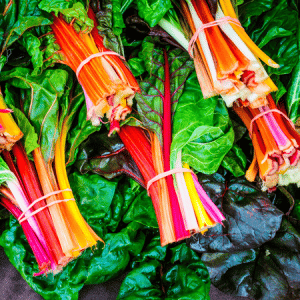…that don’t taste wholesome at all!
Swiss chard is the Goldilocks of greens. On the scale that has kale at one end and spinach at the other, Swiss chard is not too hard and not too soft. It’s juuuuust right.
Now don’t get us wrong: We Veggie Fairies do love us some kale. But sometimes even we need a break from kale’s hard in-your-face bold and bitter attitude.
And spinach, well, who doesn’t love spinach? But it is awfully mushy when you cook it and that can get kinda boring. (Please don’t tell the spinach we said that, wouldn’t want to hurt its tender widdle feelings.)
So. Swiss chard. First of all it’s gorgeous, especially the rainbow variety with its flamboyant pinks, yellows, oranges, and reds. Glams up every dish it touches. Those stylish stems are edible, too, and if you just cook them lightly they add some nice crunchy texture to the show.

Flavorwise, its milder than kale, more like spinach. But different. Nice for when you want to change things up.
Is Swiss chard from Switzerland?
Uh… no. You know how French fries didn’t originally come from France? They were probably invented in Belgium and filched by France, but that’s another story. Anyway, Swiss chard is like that. It came from a wild version of a beet that’s native to the Mediterranean region, including Italy, which is where it got named by a Swiss guy who was a botanist. Apparently, when it comes to naming rights, it’s finders keepers.
Not just a pretty face – Swiss chard is so good for you!
This green is rich in vitamins K, A, and C, plus it’s got calcium, magnesium, and loads of antioxidants. Back in the olden days, it was used as a medicine because of the good things it does for healthy digestion, immune function, blood sugar levels, and migraines. Gimme another serving of that medicine, please!
A few words of cooking guidance
The raw leaves are coarse, but give them a quick sautee or braise them and they wilt down beautifully. Try them with garlic, nuts, dried fruits, and lemon juice or vinegar – especially a sweet vinegar like fig or peach – to bring out their earthy flavor profile.
As for those yummy stems, you can cook them with the rest of the leaves. Or separately the same way you would a stem of asparagus. Or set the stems to be pickled or added to soup stock. By the way, any bitterness in Swiss chard comes from the stem, which contains a compound oxalic acid that’s found in many vegetables. The bitterness mostly disappears once the stems are cooked, but if you want it completely out of there, just remove the stems before you cook the leaves.
And now for those unwholesome tasting wholesome recipes!
Swiss chard is so versatile that it can be easy to forget some of the easier ways it can be used. Like, try this quick and simple saute. Eat it as a side or add some grilled chicken and dressing for a warm salad.
For a more complex flavor profile, we love this recipe for Wali Ya Mboga, an East African and Indian dish. You can up the Seasonal Roots quotient by using ginger from the Farm at Red Hill along with our Swiss chard. Both are available in our online farmers market when they’re in season.
Then there’s Swiss chard tahini dip. OMG, if you love hummus or baba ganoush, you’re gonna love this dip. It’s perfect with warm flatbread, chips, or raw vegetables – all of which you can get from local suppliers through Seasonal Roots.
Use Swiss chard to make this herb jam for a savory twist on your basic toast. Feel free to get creative with lemon juice, feta, or ricotta for an amazing flavor experience.
And don’t forget those colorful stems! Make pickled swiss chard stems. They’re a great way to add a crunch to your salads and grain bowls. Assuming you don’t eat them all up as snacks first.
About Seasonal Roots
Since 2011, Seasonal Roots’ online farmers market has connected Virginia families with local family farmers who use sustainable, humane practices. Our neighborhood market managers – who believe in living better through scrumptious, healthy eating, being kind to animals, protecting the environment, and spreading joy – home-deliver freshly harvested produce, pastured eggs, grass fed dairy and meat, plus artisan fare. We empower our members to eat better and live better with more nutritious, flavorful food that’s good for us and good for the planet. More info at seasonalroots.com.